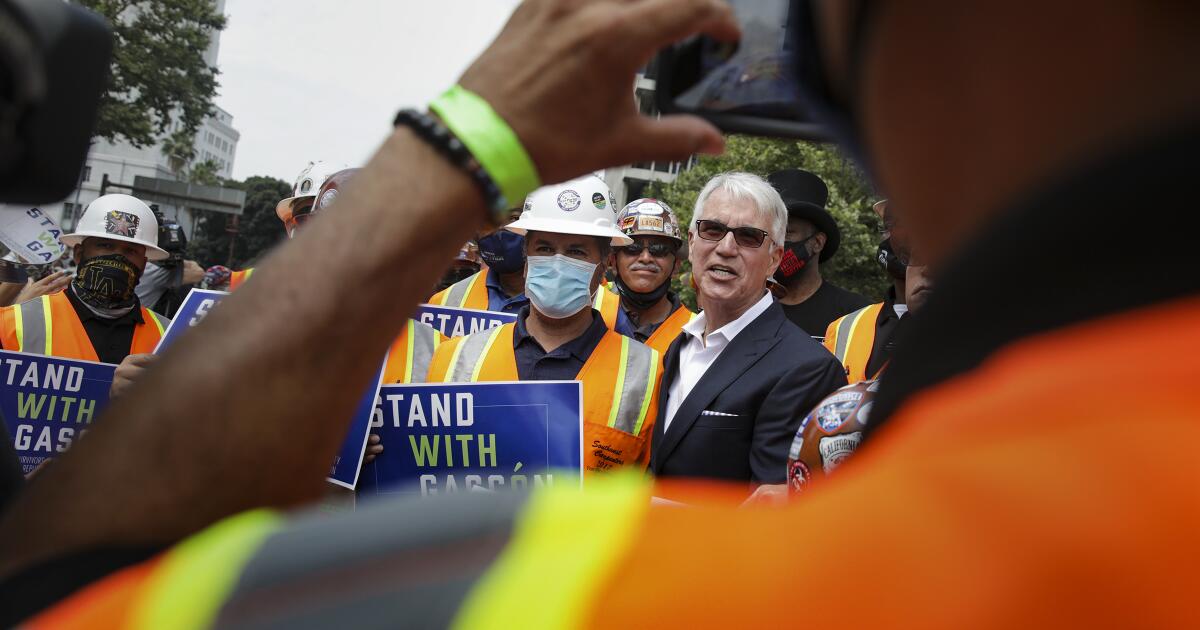Contributor: Five reasons the GOP is finally bucking Trump
President Trump’s tight grip on the GOP, long assumed to be an inevitable feature of American life (like gravity or the McRib’s seasonal return), has started to loosen.
Republicans are now openly defying him. The man who once ruled the GOP like a casino boss can’t even strong-arm Indiana Republicans into gerrymandering themselves properly.
This sort of resistance didn’t emerge overnight. It fermented like prison wine or bad ideas in a faculty lounge. First came the Iran bombing: an early shock that suggested “America First” might also mean “Israel First,” at least to the populist-nationalist camp inside the GOP.
Then came the effort to muffle the Jeffrey Epstein files, a notion so foreign to MAGA’s ethos that the subsequent drama, according to Rep. Marjorie Taylor Greene (R-Ga.), “ripped MAGA apart.”
Greene also expressed concern that the Affordable Care Act’s subsidies are set to lapse, and that Republicans have no plan to fix the imminent premium spikes — an occurrence that threatens to alienate the very working-class voters that MAGA now insists it represents.
All the while, another MAGA soap opera was churning. Tucker Carlson decided to “platform” white nationalist and Holocaust denier Nick Fuentes, leading to an outcry of criticism that prompted the Heritage Foundation’s president to defend them (sparking another Republican “civil war” subplot).
The common thread in these stories is the sense that Trump’s days are numbered. The question of “Who gets MAGA when Dad can no longer operate the remote?” has become unavoidable.
True, pundits have been prematurely writing Trump’s political obituary since he first came down that escalator. But it feels different this time. The question is why.
There are likely numerous reasons, but I’ve zeroed in on the five that I think are the most important.
The first, and most obvious, reason is that Trump is now a lame duck, and everyone knows it.
Rep. Thomas Massie (R-Ky.) made the logic explicit when, during the Epstein-file fight, he warned his colleagues: “Donald Trump can protect you in red districts right now … but by 2030, he’s not going to be president, and you will have voted to protect pedophiles if you don’t vote to release those files.”
Once politicians and influencers start imagining their post-Trump resumes, his spell over them shatters. This probably explains why Trump has dangled the idea of an unconstitutional third term.
The second reason we are seeing Trump’s grip weaken is that, frankly, Trump’s not popular. In fact, according to a new Reuters poll, his approval rating is just 38%.
This rating plummets when it comes to the issues that divide Republicans. For example, according to that same survey, a mere 20% of American adults — including just 44% of Republicans — approve of Trump’s handling of the Epstein files.
The third reason is that Trump is increasingly isolated from the constituency that once fine-tuned his political instincts.
The Trump of 2016-2020 essentially crowdsourced his political instincts at rallies, where he learned to read the room like a comedian. Now he’s physically isolated and increasingly out of touch with his base. His inner circle consists of ideologues and billionaires — people who don’t worry about the price of milk.
So when Trump insists the economy is thriving, as he hosts Gatsby-themed soirees and tears down the East Wing of the White House to build a new ballroom, populists look up from their grocery bills, spy Trump on TV meeting with the Saudi crown prince, and are suddenly flooded with buyer’s remorse. This creates an opening, and the movement’s would-be heirs can sense it.
Of course, Trump could conceivably adjust his policies and rhetoric in an effort to restore his populist appeal.
But the fourth reason for Trump’s loss of power within the GOP concerns his mortality: Trump is the oldest person to win the presidency in U.S. history. He has had two “annual” physicals this calendar year — including an MRI no one will adequately explain (this is not part of a routine physical).
This brings us to the fifth and final reason the cracks are starting to show: Trump’s 2024 coalition was always like a game of Jenga.
It was a convenient alliance of disparate factions and individuals whose interests converged because Trump’s charisma (and lack of a coherent political worldview) was like the glue holding incompatible pieces together. But as that binding force weakens, the contradictions become clear, and open warfare is inevitable.
For years now, Trump imposed peace the way an aging rock frontman keeps peace within a band. But once that star starts forgetting lyrics or showing up late, his bandmates start imagining solo careers.
We’re watching MAGA realize that the Trump era is ending, and that the next battle is about what — or who — will fill the vacuum when he’s gone.
Matt K. Lewis is the author of “Filthy Rich Politicians” and “Too Dumb to Fail.”





